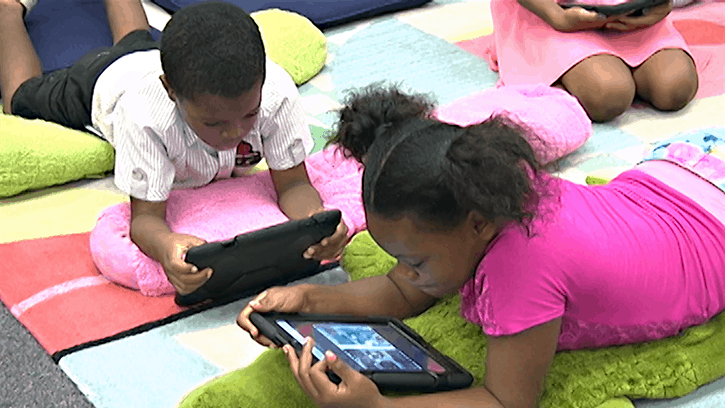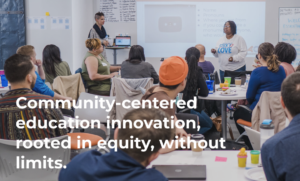Why San Francisco’s Blended, Early Literacy Program is Working

Rachel Norris
As is the case in so many districts across the country, big changes are taking place in San Francisco Unified School District (SFUSD). The district spent the past year implementing a blended, early literacy program that engages whole families. This implementation is part of a larger process that has involved community-wide visioning, aligning strategic plans and resources, piloting new approaches and moving toward scalability. What did that look like and what are some key lessons learned?
Community-Wide Visioning: The district captured its ambitious goals for the future in their Vision 2025 community-wide initiative, which pictures what a thriving, prepared graduate should look like in 2025. Stakeholders from across the district and the wider Bay area collaborated over a several-month, facilitated process to analyze data and trends in order to design long-term, achievable goals for their students. The resulting 2025 Graduate Profile describes students that develop and manage global, local, and virtual identities; who are multilingual, technologically fluent and college- and career-ready, including many jobs that do not yet exist.
Aligning Living Plans and Strategic Work: The district is utilizing the resulting document, Vision 2025, with its ten identified “Big Shifts” as a guide star for its current, evolving strategic plan: Impact Learning, Impact Lives:
- A Graduate Profile
- Personalized Pathway
- Re-Imagined Space
- Motivation & Mastery
- Real-Life Tasks
- Cultural Competence & Multilingualism
- Blended Learning
- Talent & Collaboration
- Innovative Systems
- Aligned Investments
So, yes, the district is rolling out the Common Core in ELA and Math as many districts are around the country – but also strategizing to do that equitably for underserved learners (e.g., students who are low-income who are disproportionately African American and Latino, and students with special needs and those who are English Language Learners) AND with a future-focus. The future-focus includes making investments in and developing programs required for being an effective “Digital District,” that supports the Graduate Profile (so backward-mapping plans from the profile of what students should know and be able to do, to what learning environments should look like and what students should be doing in them today).
Partnering with Business, Community and Philanthropy: To realize their ambitious plans SFUSD also acknowledges the need for effective partnerships with local industry leaders, specifically tech companies, philanthropies and community organizations in helping to pilot new approaches, to invest in key infrastructure and to ensure strategic capacities are in place to make the Ten Big Shifts. In the case of equity-focused innovations around literacy learning, district stakeholders found that Mark Zuckerberg and Priscilla Chan were interested in their School and Family Early-Digital Literacy Pilot, and so they approached their Startup: Education Foundation about a partnership. The Foundation’s vision of involving parents and children together in learning fit perfectly with the district’s ideas.
Private Investments to Help Inform Future Public Investment: Due to the support of Startup: Education, the initiative does not rely heavily on public funds for the pilot. It was important to both that the initiative for change should focus on reading and writing; it should be:
- mindful of whole-child education and other issues facing their students;
- innovative; and importantly
- a community-wide effort, involving local community-based organizations as partners in the work.
Private funding allows for innovation that can inform later public investments.
Creating a Strategy and Fund Development Team: To attract Startup: Education and other funders to the district, the district’s newly formed Strategy and Fund Development Team, has worked hard to emphasize good internal administration of funded projects and responsiveness to the community. Lines of communication between funding sources and school leaders were established and are carefully maintained. An important step is to identify sponsorship within the district for newly funded pilots/programs to ensure thoughtful attention to implementation, with appropriate feedback loops to district senior leadership and to funders. In acknowledgement of this important function, SFUSD created a separate, but affiliated, 501(c)3 nonprofit to attract and manage private foundation and corporate funds.
Build on Recent Research-Based Successes: SFUSD leaders had recent success turning around school performance in their formerly “persistently lowest performing schools,” and found that among the most effective strategies was resourcing schools with robust, classroom libraries with books at all reading levels and building professional capacity for implementing a research-based comprehensive literacy framework workshop approach embodied in Readers and Writers Workshops. The district is working systematically to disseminate these evidence- and research-based approaches across the district. The School and Family Early-Digital Literacy Pilot then helps to improve on that with the effective, integrated use of devices at the four pilot elementary schools (all selected as underserved schools in the district). As part of the program, each first grader is given access to thousands of age-appropriate digital books through myON, an online personalized literacy environment.
Curriculum/Professional Development Partners in Implementation: SFUSD worked with nonprofit partner Wexford Institute to develop a more robust family early-digital literacy-training program. Twenty modules, each taking one hour over ten sessions, introduce parents to the program and to provided iPad. Modules teach ways to connect with their child’s teacher, ways to help their child practice reading and writing, and use of specific apps. Additionally, the lessons provide parents the opportunity to network with each other.
Learn-To-Earn Family Devices: Each family received an iPad that they earned by completing the program and can then keep the devices indefinitely. It’s theirs to keep and use, separate from classroom sets provided to the schools. Each device is loaded with reading and writing software, ensuring that students and parents alike have access to the tools needed to succeed.
Leveraging Technology: Parent training materials are available on paper and in iTunes University as downloadable iBooks. When the possibility was raised that whole families might use the vast children’s library, separate family accounts were created to ensure access to books at home, while tracking first grade students’ data cleanly, separate from other family members’ use.
Equity-Focused Piloting: Mindful of the importance of testing and research, as well as sustainability concerns, the new digital program was rolled out in carefully chosen first grade classrooms at four of the district’s elementary schools. “We consulted with ELA teachers and district coaches, and found that first grade is the perfect place to start,” explained Kevin Rocap, Executive Director of Strategy and Development. Kevin said:
“First grade is when students are expected to make the greatest leap in reading ability. The new Common Core state assessments begin for students in the second grade, so first graders will not be distracted by the new testing requirements as they boost their reading ability.”
As an added bonus, as children learn to read, they also become more comfortable with technology they will need to be successful learning and in taking new, device-based assessments.
Thoughtful Scaling: The district looks to grow the program in coming years, currently considering expanding their first grade strategy across the district and/or expanding upwards into the second grade and downwards to kindergarten and pre-k. One thing is certain. They will incorporate as much careful research, evidence and new learning in their decision as possible, aiming to engage whole communities in meaningful change.
For more, check out:
- Utah Boosts Kindergarten Readiness with Literacy Games At Home
- Early Childhood Education is Critical for our Own Kids’ Future – and the Nation’s
- WriteReader: Flipping the Script on Literacy

Rachel Norris is a freelance writer for Education and other industries.







0 Comments
Leave a Comment
Your email address will not be published. All fields are required.